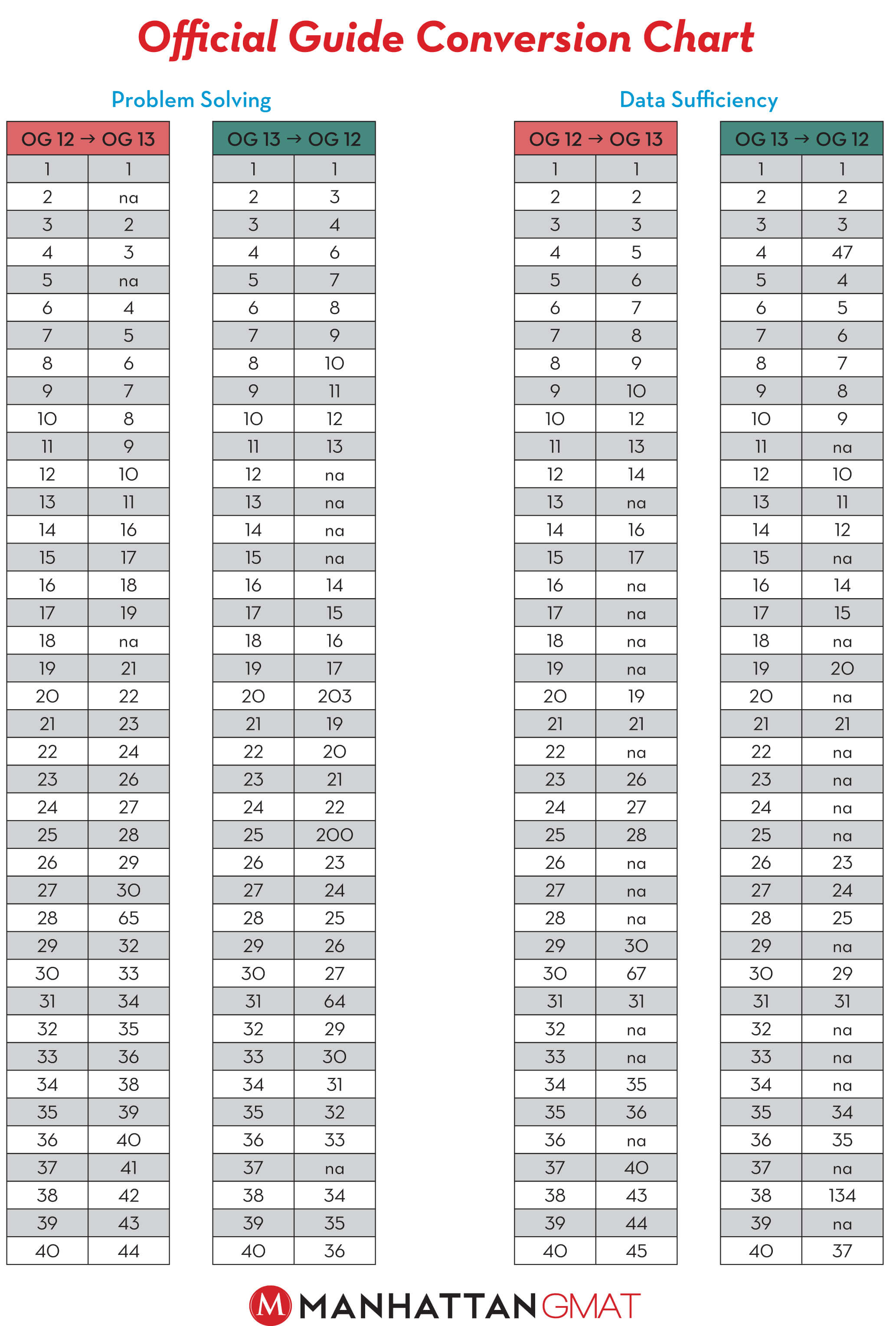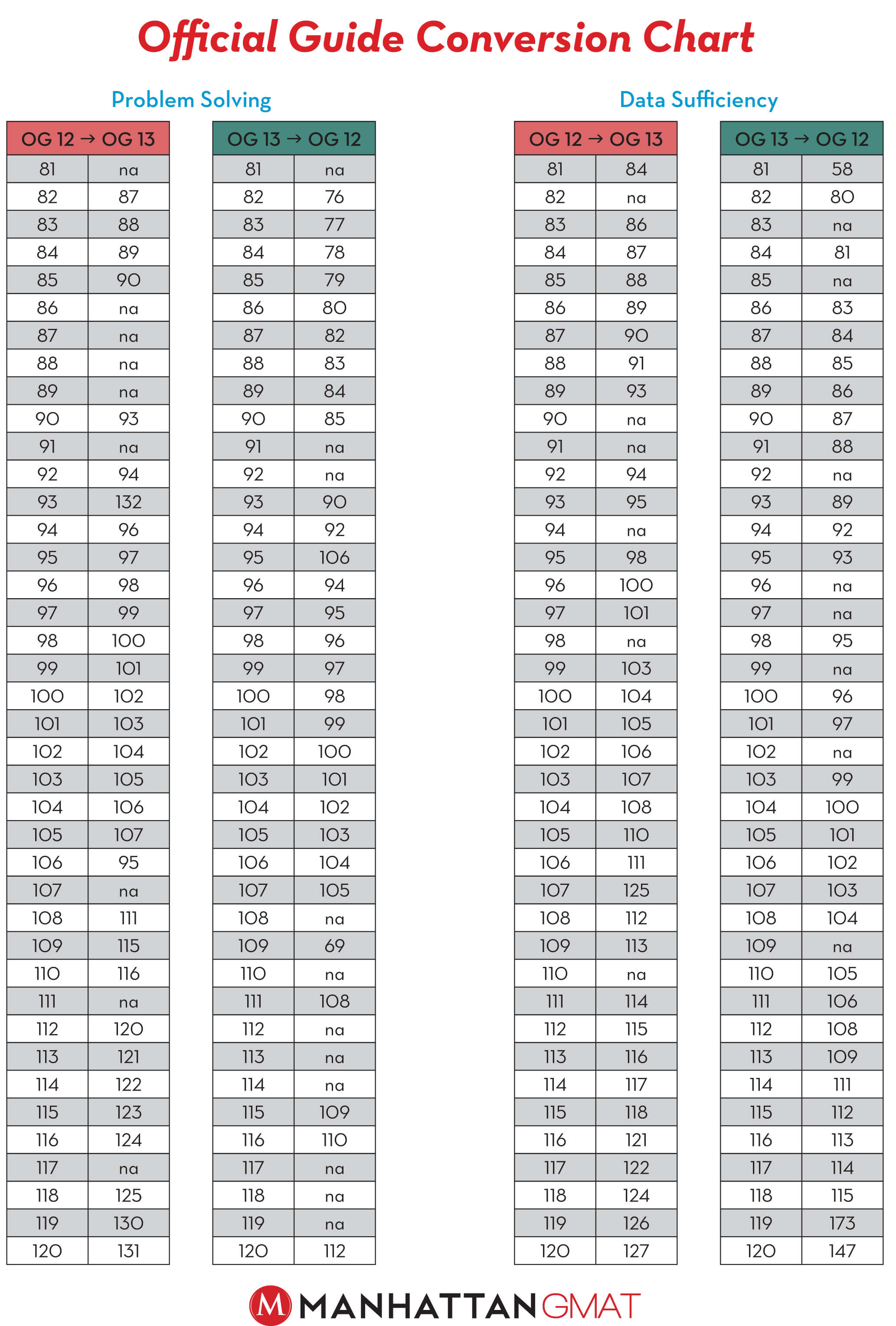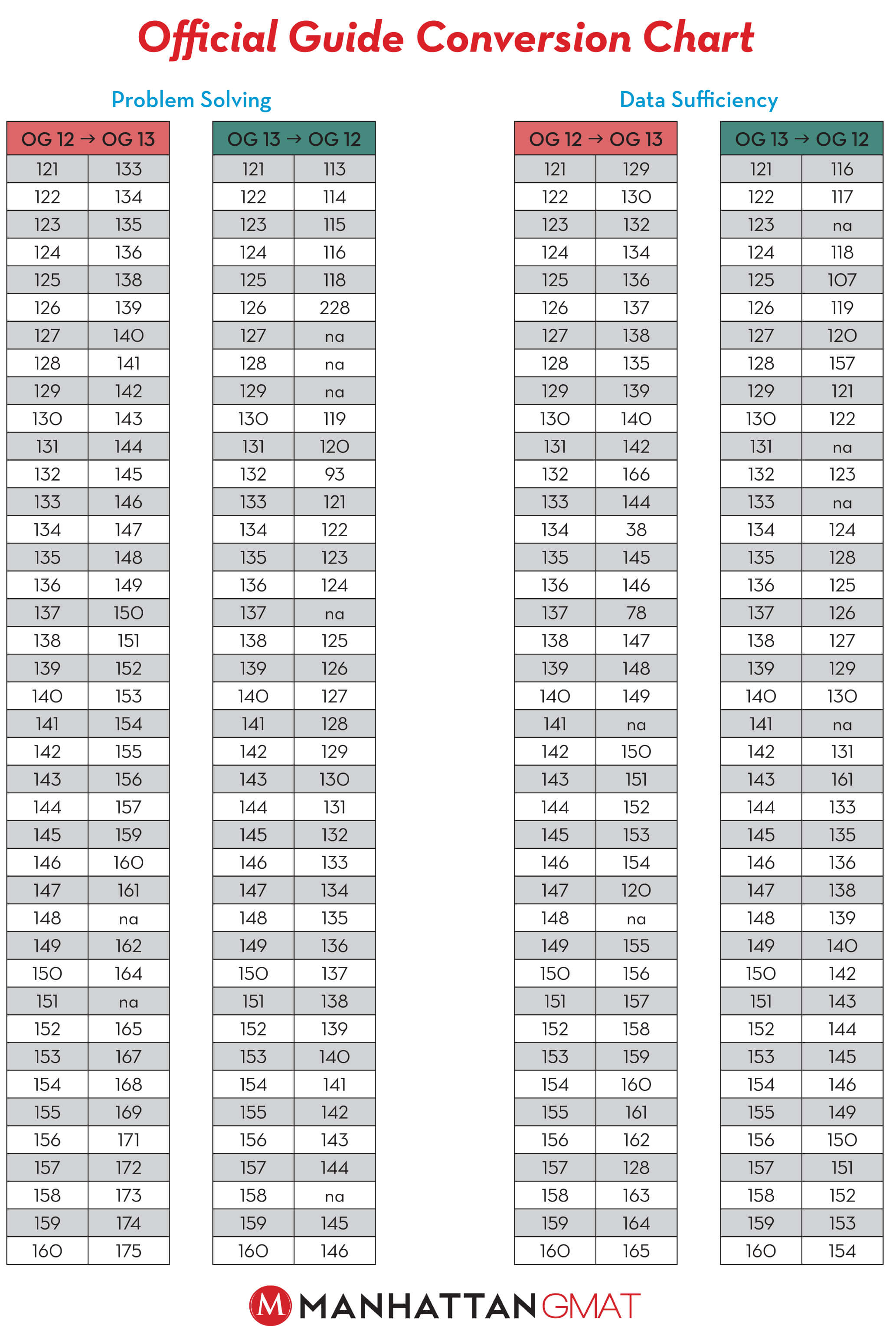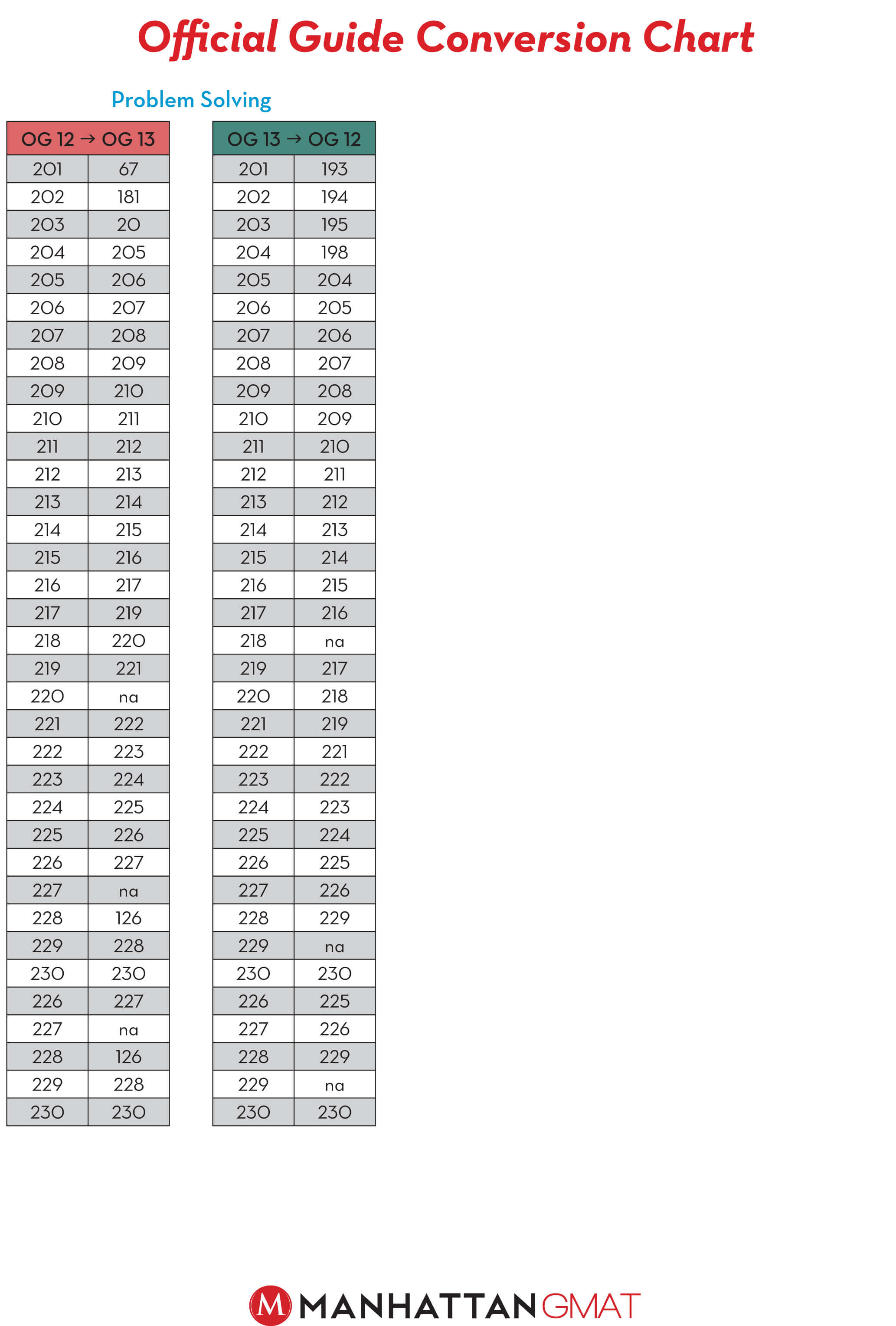OG 13 Conversion Guide – Quant
Need to convert your Official Guide 12 problems to OG13 problems? Or visa versa? Check out our hand-dandy conversion guide for Quant problems, below. You can find our conversion guide for Verbal problems here.
Challenge Problem Showdown- April 8, 2013

We invite you to test your GMAT knowledge for a chance to win! Each week, we will post a new Challenge Problem for you to attempt. If you submit the correct answer, you will be entered into that week’s drawing for a free Manhattan GMAT Prep item. Tell your friends to get out their scrap paper and start solving!
Here is this week’s problem:
If a, b, and c are integers such that 0 < a < b < c < 10, is the product abc divisible by 3?
(1) If  is expressed as a single fraction reduced to lowest terms, the denominator is 200.
is expressed as a single fraction reduced to lowest terms, the denominator is 200.
(2) c “ b < b “ a?
Free GMAT Events This Week: April 8- April 14
Here are the free GMAT events we’re holding this week. All times are local unless otherwise specified.
4/8/13– San Francisco, CA – Free Trial Class – 6:30PM- 9:30PM
4/8/13– Online- Assessing Your MBA Profile presented by mbaMission– 12:00PM- 1:30PM
4/8/13– Santa Monica– Free Trial Class- 6:30PM-9:30AM
4/8/13– Online– Free Trial Class- 8:00PM- 11:00PM (EDT)
4/9/13– Salt Lake City, UT- Free Trial Class– 6:30PM-9:30PM
4/9/13– Chicago, IL – Free Trial Class – 6:30PM- 9:30PM
4/9/13– San Diego, CA – Free Trial Class – 6:30PM- 9:30PM
4/10/13– Phoenix, AZ – Free Trial Class- 6:30PM- 9:30PM
4/10/13– Bellaire, TX – Free Trial Class- 6:30PM- 9:30PM
4/10/13– Ann Arbor, MI – Free Trial Class- 6:30PM- 9:30PM
Read more
Friday Links: B-School Tuition, Board Members With MBAs, & More!
Catch up on some business school news and tips with a few of this week’s top stories:
Who’s Smarter? Law or Biz Students? (Poets & Quants)
Poets & Quants explores the provocative and tongue-in-check question of whether business students are smarter than law students or vice versa.
Business School Tuition: An Overview of Business School Tuition Costs (About.com Business School)
While the cost of business school is notoriously expensive, it is important to remember that there are many different ways to lower and pay your business school tuition.
Should Entrepreneurs Get an MBA? An Inside Perspective From an MBA Entrepreneur (Forbes)
An entrepreneur interested in startups shares how the majority of successful entrepreneurs and investors that she admires hold an MBA.
Read more
This Problem is Work!
 Raise your hand if you love rate and work questions. They’re awesome, right? They tend to be fairly long, and the set-up is pretty complex, plus we get to build a table before we dive into the equations!
Raise your hand if you love rate and work questions. They’re awesome, right? They tend to be fairly long, and the set-up is pretty complex, plus we get to build a table before we dive into the equations!
Oh, wait no those are all reasons why we can’t stand these problems.
Give yourself approximately 2 minutes to try the below GMATPrep problem. When you’re done, take a look at it again and ask yourself, Is there a better way to do this thing?
* Pumps A, B, and C operate at their respective constant rates. Pumps A and B, operating simultaneously, can fill a certain tank in 6/5 hours; pumps A and C, operating simultaneously, can fill the tank in 3/2 hours; and pumps B and C, operating simultaneously, can fill the tank in 2 hours. How many hours does it take pumps A, B, and C, operating simultaneously, to fill the tank?
(A) 1/3
(B) 1/2
(C) 2/3
(D) 5/6
(E) 1
Have you got an answer? Pick one anyway. Pretend it’s the real test: you can’t keep going till you pick an answer.
Challenge Problem Showdown- April 1, 2013

We invite you to test your GMAT knowledge for a chance to win! Each week, we will post a new Challenge Problem for you to attempt. If you submit the correct answer, you will be entered into that week’s drawing for a free Manhattan GMAT Prep item. Tell your friends to get out their scrap paper and start solving!
Here is this week’s problem:
The ratio of a to b is twice the ratio of b to c. If a, b, and c are positive integers, which of the following statements cannot be true?
Free GMAT Events This Week: April 1- April 7
Here are the free GMAT events we’re holding this week. All times are local unless otherwise specified.
4/2/13– Boston, MA – Free Trial Class – 6:30PM- 9:30PM
4/3/13– New York, NY- Choosing the Right B-School presented by mbaMission– 7:00PM- 8:30PM
4/3/13– Online- Free Trial Class- 9:00PM-12:00AM (EDT)
4/3/13– Evanston, IL- Free Trial Class- 6:30PM- 9:30PM
4/4/13– Online- Thursdays with Ron– 7:00PM-8:30PM (EDT)
4/7/13– San Antonio, TX – Free Trial Class – 5:30PM- 8:30PM
4/7/13– Online – Free Trial Class – 5:30PM- 8:30PM (EDT)
4/3/13– London – Free Trial Class- 2:00PM- 5:00PM
Looking for more free events? Check out our Free Events Listings Page.
Friday Links: Great Jobs for MBA Grads, How to Borrow for an MBA, & More!
 Catch up on some business school news and tips with a few of this week’s top stories:
Catch up on some business school news and tips with a few of this week’s top stories:
6 Great Jobs for MBA Grads (U.S. News Education)
Trying to decide what to do after you’ve been accepted into an MBA program? Here are a few outstanding careers that may be a good fit.
Mistakes to Avoid During the MBA Admissions Process (Graduate Guide)
It’s important for prospective business students to be aware of the common admissions mistakes. Here is some helpful advice to avoid application pitfalls.
An Interview with Stanford Dean Garth Saloner (Poets and Quants)
The dean of the most expensive MBA program in the world talks about why business school is worth every penny.
Read more
Lifting Your GMAT Score
 How do you maximize your score on the GMAT? Sure, you have to learn to answer harder questions correctly “ but that’s not actually enough.
How do you maximize your score on the GMAT? Sure, you have to learn to answer harder questions correctly “ but that’s not actually enough.
Let’s stipulate a couple of things. First, whenever I say easier or harder in this post, I’m referring to easier or harder for you, the reader; everything here is relative to your current scoring level and your desire to lift that level to whatever your goal score is. In other words, this works at every level and for every goal.
Second, as a general rule, you take (on average) more time to answer harder questions than you take to answer easier ones.
Okay, what does that mean? Most people don’t spend much time studying the things that they generally already know how to do; they don’t analyze questions that they answered correctly unless there was some other issue (such as spending too much time).
Update of GMATPrep software is definitely worth downloading!
The new release of GMATPrep, version 2.2, is a significant upgrade!
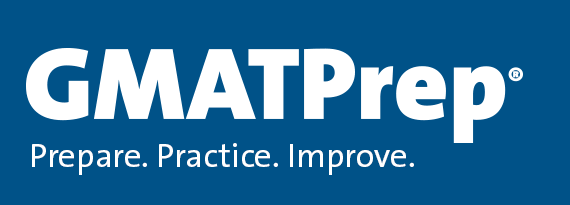 The biggest improvement is that the software now allows you to review previous practice problems and tests. I was excited when I saw this feature listed in the README and I was thrilled when I found that I could actually review the practice problems and the tests that I took last year! Thank you, GMAC! This is enormously helpful for test takers.
The biggest improvement is that the software now allows you to review previous practice problems and tests. I was excited when I saw this feature listed in the README and I was thrilled when I found that I could actually review the practice problems and the tests that I took last year! Thank you, GMAC! This is enormously helpful for test takers.
The default for both practice problem sets is now to do what most people want to do, which is to save the test for later review, and the new user interface makes it very hard to accidently delete a practice test. You have to press a test ˜reset’ button and then go through a dialog to reset your tests, another big improvement.
I was also delighted to see that in the practice utility, the Reading Comprehension problems are now grouped correctly. In the previous versions of GMAT Prep, each RC practice problem included an entirely new passage, unlike the real test, where of course each passage has 3 or 4 associated questions. This is another significant improvement and makes the practice utility more helpful for people who are working on RC or who want to do mixed verbal sets. Since this new feature works correctly with mixed drills as well, you can now use GMATPrep to specify realistic verbal mixed sets, with SC, CR, and RC problems, as well as realistic quant mixed sets of PS and DS problems.
Although the two practice tests still seem to have only one IR section, an IR percentile ranking is now computed, which is helpful.
There are is also some new timing analysis available in practice sets, along with some at least moderately useful progress tracking graphs for examining progress on practice sets.
And speaking of time, you can now pause a practice exam or question session. Although you really shouldn’t do this if you want a realistic practice experience, sometimes it is helpful, such as when you are writing a review of the software and need to test features and then write about them. J
GMAC must be thinking more about customer support because you can now generate system information at the click of button, which makes things much easier if you ever need to call of email GMAC about a software problem.
And finally, if you are a test taker with a GMAC approved timing accommodation, you can ask for a special code that you enter that will allow you to take practice tests with the appropriate amount of extra time.
All in all, very well done GMAC! I noticed a couple of weird little bugs that I’ve listed below, but they are minor compared to the improvements and have easy workarounds, which I’ve described.
Weird Little Bugs:
- You have to enter your mba.com account name and password when you first launch GMATPREP and if you are logged in to mba.com when you try this, you will get an unhelpful unknown error message. If you see this message, just log out of mba.com’s website and try starting GMAT Prep again.
- When you solve an IR table question, the ˜submit’ button will be grayed out until you click on sort by a column “ even if you have filled in all of the answers “ so just remember to click on something to sort by if you didn’t actually have to sort (and usually you will have to) to answer the question.
